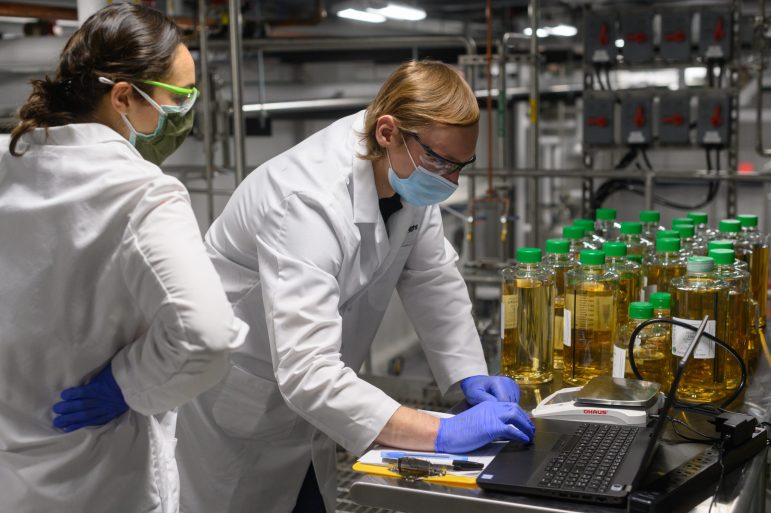



January 20, 2022



January 20, 2022
Original article published in Rochester Beacon
Ten years after its Jan. 19, 2012, bankruptcy filing, a diminished Kodak is still finding its way in the post-film world as a technology company focused on print, advanced materials and chemicals.
In the first nine months of 2021, it reported $843 million in total revenues, compared with more than $3.6 billion through three quarters of 2011. Just before its bankruptcy filing, Kodak employed more than 5,100 workers in the Rochester area; by the end of 2020, its global workforce had declined to 4,500, with roughly 1,900 employed in the U.S.
Yet Kodak’s presence in Rochester remains sizable—in large part because of Eastman Business Park. Founded in 1890, the complex has played an integral role in the Rochester area, as a job and revenue generator for Kodak. Today, the 1,200-acre campus owned by Kodak serves as an industrial manufacturing complex for 117 companies from around the world.
EBP tenants operate in a mix of emerging industries such as biomaterials manufacturing, energy storage, and chemical manufacturing. Some of them have expanded their operations in the region after establishing a presence at the park.
Currently, Kodak estimates that 5,500 people are employed at the park, with 1,100 working for Kodak. The rest are employed by EBP’s tenants.
The park has generated millions of dollars in revenue for Kodak. In its most recent annual report filed with the Securities and Exchange Commission, Kodak stated that EBP’s operations generated $11 million in external revenue in 2020, most of which was rent.
Dave Bullwinkle, chief financial officer at Kodak, estimates that this figure will grow by about 35 percent, reaching $14 million to $15 million, for the year ended Dec. 31.
“We’re really hoping to spur the economy by offering space and infrastructure for companies to maintain their business operations in New York,” Bullwinkle says.
An established history
Eastman Business Park’s history is closely tied to Kodak’s success as a photography company. Formerly known as the largest photographic product manufacturing facility in the world, the location at one time employed more than 15,000 Kodak employees. The photo giant used the space to manufacture cameras, produce film, and support other company efforts.
During both world wars, the location—then known as Kodak Park—supported the home front by manufacturing aerial cameras and processing military film.
In the 1930s, Kodak Park produced Kodachrome, the film that would revolutionize the film industry, capturing countless “Kodak moments” over the course of the 20th century.
The company started welcoming tenants, many of which were suppliers for Kodak’s manufacturing, during the 1990s. In 2008, amid Kodak’s downsizing, the company changed the property’s name to what it is today, focusing on attracting more tenants to its unoccupied buildings.
In the years that followed, film’s obsolescence and other factors shrank Kodak’s traditional business relentlessly. In January 2012, it filed for reorganization under bankruptcy protection. Since then, EBP has been continuously transforming into a place that allows other businesses to take advantage of the industrial facility’s assets.
Access to resources
A key asset is the existing infrastructure that provides the park’s tenants with access to resources that are crucial for their operations. In total, EBP boasts more than 16 million square feet of manufacturing facilities, labs, and office space.
The park provides tenants with access to a wastewater plant that can treat 36 million gallons daily and an industrial water supply that can process 54 million gallons each day. It also has a 117-megawatt power plant that produces electricity, steam, and chilled water.
Access to these resources is one of the reasons why companies like Li-Cycle are establishing operations here. The Mississauga, Ont.-based lithium battery recycling company has had a presence at the park since the fall of 2020 and currently employs 30 to 40 employees there.
Kunal Phalper, the company’s chief strategy officer, says his organization “took a holistic look at North America and different industrial parks to see where do we find a site that is best suited for this type of operation.”
Li-Cycle uses both mechanical and chemical processes to achieve its sustainability goals. Access to analytical labs, a fire department, and other EBP services convinced Li-Cycle to move some of its operations here.
Other tenants at the park echo Phalper. GreenLight Biosciences, a Massachusetts-based company that established a presence in Rochester in 2020, hopes to produce affordable RNA technology to support vaccine development, agriculture production, and other sustainability-related projects.
Catie Lee, vice president of marketing at GreenLight, believes that the park’s purpose-based capabilities are what ultimately attracted the company to the region. GreenLight Biosciences believes that its $16.6 million, 17,000-square-foot plant at EBP is the largest RNA facility in the world and, Lee says, will help it to achieve its goal of commercializing RNA solutions on a large scale.

Through the Empire State Development Program, GreenLight is scheduled to receive $600,000 from the state for its commitment to increasing employment at EBP.
Other notable additions to the park over the years include ON Semiconductor, a supplier of devices for cars, cell towers, and the military, and Plug Power, a company that develops hydrogen fuel cells for vehicles and other stationary applications.
Over the last few years, both companies have heavily invested in growing their current operations at the park. In 2018, ON Semiconductor—now known as Onsemi—invested $6 million to fund the expansion of its current facilities at EBP, and New York gave the company a $4.3 million grant.
Plug Power recently expanded its presence at the park, announcing in 2019 that it would invest $3.7 million to fund a membrane electrode assemblies facility. The facility was expected to create 80 new jobs, and promote further economic growth. Since then, the company has bolstered its commitment to the region, announcing a $125 million innovation center in Monroe County that would bring 377 new jobs and plans to establish the largest green hydrogen fuel production facility in North America in Genesee County, creating 68 jobs.
Room for growth
Eastman Business Park still has 400 acres of undeveloped land—a boon for tenants. Li-Cycle plans this year to open its North American hub there; it will be able to recycle approximately 66,000 tons of lithium batteries and create some 150 permanent jobs. The company is investing $175 million to build the recycling hub as it expands its presence in the Rochester area.
In addition, companies like GreenLight expect to scale up their employment at the park. The company forecasts boosting its employment there from 12 to 30 workers, to support its plans to center of much of its production—including its entire agricultural pipeline—at the park.
Even larger companies, like Amazon, have decided to move some of their operations to EBP. In November 2020, Amazon said its $50 million distribution warehouse would be built on the property in Greece, creating 50 full-time and 50 part-time jobs.
Over the next few years, Kodak also would like to use the park to support its own business units.
“We’re really focused on opportunities where there is a synergy between our businesses and our tenants’ businesses,” Bullwinkle says.
Several tenants support Kodak as suppliers or customers. Additionally, Kodak would like to attract more local and out-of-town tenants.
“We see a number of companies that are expanding in the Rochester area, so if they outgrow their space, they always have a choice for where they can go to manufacture,” Bullwinkle says.
He adds: “By providing (companies) with this type of infrastructure, we can keep jobs in Upstate New York, which is really important.”
Mark Valenti is a senior at St. John Fisher College. Homepage photo courtesy of GreenLight Biosciences.
